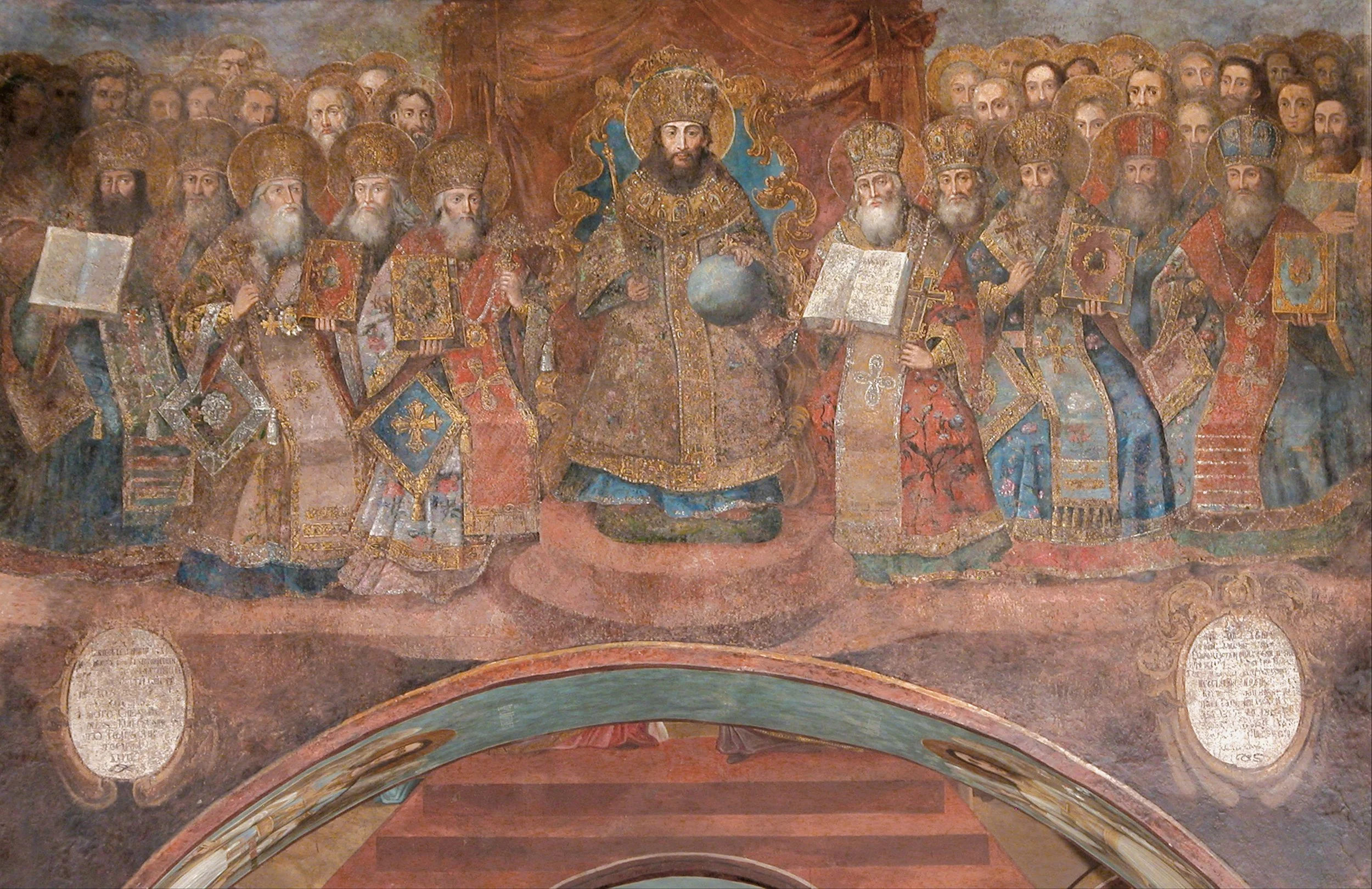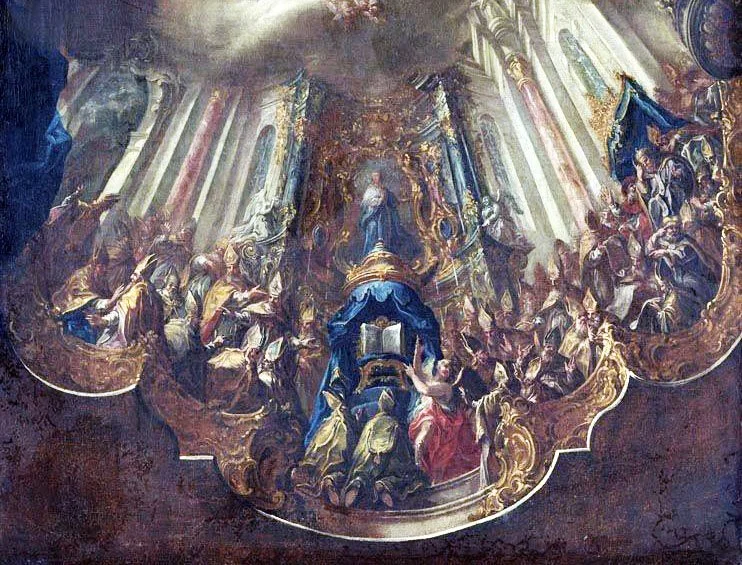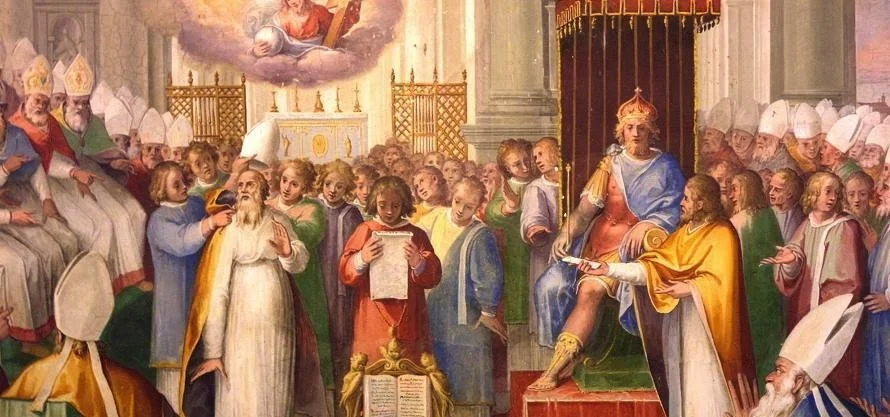
Councils & Creeds
Compass
The Middle Councils
High Medieval Councils
Early Modern Councils
The Last Great Council
The Creeds · Profession of the Faith
"Begotten, not made, being of one substance with the Father."
Nicea I (AD 325)
"If anyone does not confess that Emmanuel is God in truth, and therefore that the Holy Virgin is the Mother of God (for she bore in a fleshly way the Word of God become flesh), let him be anathema."
Ephesus (AD 431)
“Peter has spoken through Leo!”
Chalcedon (AD 451)
The Church As One Body
An Ecumenical Council is the most solemn and authoritative assembly of the teaching Church (Magisterium), gathering the Bishops from the entire world under the headship of the Roman Pontiff, the Vicar of Christ, to deliberate, legislate, and define matters of faith and morals for all Catholics.
These Councils are instituted to address and extinguish spreading errors, to clarify and define necessary doctrines, to safeguard discipline, and to strengthen Christian piety, acting as the chief instrument through which the Holy Spirit maintains the infallible Truth of the Church against infiltration and heresy throughout the ages.
The decrees of an Ecumenical Council, once confirmed by the Successor of Saint Peter (the Pope), bind the consciences of all the faithful, serving as permanent, unchangeable monuments of orthodox teaching that ensure the continuity and integrity of the sacred deposit of Faith given by Our Lord to His Apostles.
The Early Councils
The faithful Catholic must recognize that the Holy Spirit, promised by Our Lord, has perpetually guided the Church to preserve the sacred deposit of Faith, most especially through the Ecumenical Councils. Following the persecutions of the early centuries, the rise of impious heretics—enemies of Christ who sought to corrupt the divine truths—necessitated these solemn assemblies of Bishops, who, gathered under the guidance of the Holy See, acted as the definitive and infallible voice of the Church. From the First Council of Nicæa (325 A.D.) to the Second Council of Nicæa (787 A.D.), these seven venerable Councils established the foundation and framework of orthodox belief by defining the true nature of the Most Holy Trinity and the Person of Jesus Christ. These decrees serve as the immovable bulwarks against all doctrinal error, ensuring that the flock remains securely within the boundaries of Truth, and demonstrating the Church's constant, supernatural protection against the gates of hell.
The Seven Pillars of Orthodoxy:
Nicæa I to Nicæa II
The early Councils acted as the unshakeable pillars of the Catholic Creed, decisively confronting and condemning those who sought to dismantle the core mysteries of salvation. The Councils of Nicæa I (325), Constantinople I (381), and Ephesus (431) established the essential doctrines concerning the Godhead, clarifying the divinity of the Son against the Arian blasphemy and defining Our Lady as the Theotokos (Mother of God) against the Nestorian error. The subsequent Councils of Chalcedon (451), Constantinople II (553), and Constantinople III (680-681) firmly defined the two natures (divine and human) and the two wills in the Person of Jesus Christ—perfect God and perfect man—against the Monophysite and Monothelite heresies, thus safeguarding the full reality of the Redemption. Finally, the Second Council of Nicæa (787) defended the pious and ancient practice of venerating sacred images, asserting that the honor paid to the image passes to the prototype, thereby confirming the sacramental and visible nature of the Faith against the wicked Iconoclasts. To accept the teachings of these Councils is to accept the entirety of the revealed Faith.
I. The Early Councils (Foundations of Orthodoxy)
Nicaea I (325)
Constantinople I (381)
Ephesus (431)
Chalcedon (451)
Constantinople II (553)
Constantinople III (680–681)
Nicaea II (787)
II. The Middle Councils (Christendom & Authority)
Constantinople IV (869–870)
Lateran I (1123)
Lateran II (1139)
Lateran III (1179)
Lateran IV (1215)
(Here the tone shifts toward discipline, governance, and sharpening the Church’s universal mission.)
III. The High Medieval & Early Modern Councils (Defense & Reform)
Lyons I (1245)
Lyons II (1274)
Vienne (1311–1312)
Constance (1414–1418)
Florence (1431–1449)
Lateran V (1512–1517)
Trent (1545–1563)
(This is the golden thread of Catholic response to crisis — East/West schism, reform, Protestant revolt.)
IV. The Last Great Council
Vatican I (1869–1870)
V. The Creeds (Profession of the Faith)
Apostles’ Creed (used in baptismal context, Roman origin)
Nicene-Constantinopolitan Creed (325/381, liturgical use)
Athanasian Creed (Quicumque vult, doctrinal clarity)
Roman Creed / Old Roman Symbol
Other local baptismal symbols (Gallican, etc.)
Origins (Apostles’ / Old Roman → Nicene → Athanasian).
Use (Baptismal, Liturgical, Doctrinal/Apologetic).
Relation to Councils (e.g., Nicene Creed explicitly tied to Nicaea/Constantinople).






